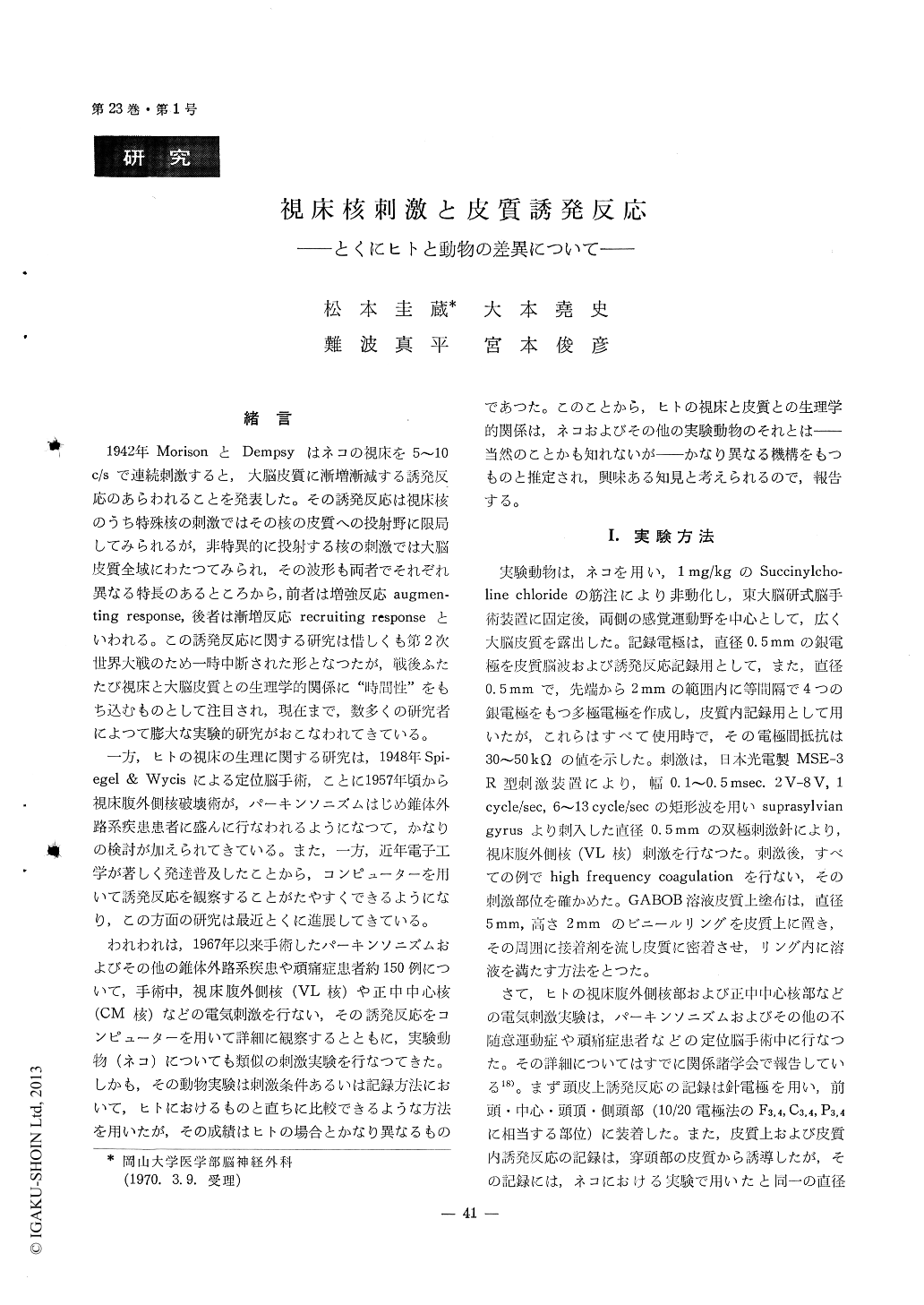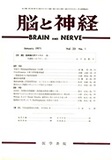Japanese
English
- 有料閲覧
- Abstract 文献概要
- 1ページ目 Look Inside
緒言
1942年MorisonとDempsyはネコの視床を5〜10c/sで連続刺激すると,大脳皮質に漸増漸減する誘発反応のあらわれることを発表した。その誘発反応は視床核のうち特殊核の刺激ではその核の皮質への投射野に限局してみられるが,非特異的に投射する核の刺激では大脳皮質全域にわたつてみられ,その波形も両者でそれぞれ異なる特長のあるところから,前者は増強反応augmen—ting response,後者は漸増反応recruiting responseといわれる。この誘発反応に関する研究は惜しくも第2次世界大戦のため一時中断された形となつたが,戦後ふたたび視床と大脳皮質との生理学的関係に"時間性"をもち込むものとして注目され,現在まで,数多くの研究者によって膨大な実験的研究がおこなわれてきている。
一方,ヒトの視床の生理に関する研究は,1948年Spi—egel & Wycisによる定位脳手術,ことに1957年頃から視床腹外側核破壊術が,パーキンソニズムはじめ錐体外路系疾患患者に盛んに行なわれるようになって,かなりの検討が加えられてきている。また,一方,近年電子工学が著しく発達普及したことから,コンピューターを用いて誘発反応を観察することがたやすくできるようになり,この方面の研究は最近とくに進展してきている。
Single and repetitive stimulations of the nucleus ventralis lateralis (VL), centrum medianum (CM) and ventralis anterior (VA) of the human thalamus were carried out on over 150 patients of parkinsonism, intractable pain and the other behavior disorders.
Single stimulations of the VL nucleus of the hu-man thalamus usually evoked bilateral responses on both centro-frontal areas using averaging computer technique. The summated evoked responses demon-strated clear three negative phases, that is, the first negative wave with peak time of 10 msec (I-N), the second (positive) negative wave with peak time of 50 msec (II-N) and the third negative wave with peak time of 80-100 msec (III-N).
Configulation of the summated evoked potentials with that of summated potentials with stronger stimuli show completely similar pattern with weaker stimuli. Furthermore, there was little discrepancy of the peak time of the three negative waves in the potentials between left and right patterns.
Now, computer recordings in the bilateral central sites were carried out on some patients of parkin-sonism, who were stimulated at several points with the withdrawal of the stimulating needle from the VL nucleus of the thalamus. On this series of the recording, the amplitude of the II-PN phase was maximum when the stimulating needle was thought to be in the center of the VL nucleus, and disappeared at the point of 10-15 mm to the target.
The latency of the I-N wave was able to mini-mize as less as 5 msec in the computer record and the latency period had been noted to be fairly equal on both sides in the majority of the trials. It was very interesting that the amplitude of the I-N wave increased proportionately with the stimulating inten-sity within some limits. The phenomenon was noted bilaterally.
Now, after application of 5% GABOB solution on the cerebral cortex, the amplitude of the I-N wave was markedly depressed, and after coagulation of the cortical superficial layers, the polarity of the I-N wave was completely reversed.
Simultaneous recording of the responses were per-formed at the several points in the cortex. The I-N wave, which was seen on the cortical surface, showed reversed polarity and positive wave in thedeeper layers of the cortex. Superficial II-PN wave showed completely reversed polarity in the deeper layers of the cortex after passing through the so called "the zone of isopotentiality" as well.
It would be supposed that the I-N wave is the response transmitted through rather simple phys-iological pathway from the VL nucleus to the bi-lateral centro-frontal areas. of the cortex, perhaps with simple synaptic reley system. However, the II-PN wave is the response transmitted through complex system with the synapses in the depth of the cortex, perhaps in the III-V layers of the cortex.
Now, repetitive stimulations of the VL nucleus of the human thalamus evoke bilateral cortical re-sponses, whose distribution is similar to that of single stimuli. In only two cases of over 150 parkin-sonian patients, who were stimulated at the VL nucleus of the thalamus, stimulations of the VL nucleus with 10 volts and more evoked no responses at all, but repetitive stimulations evoked clear bilateral monophasic negative responses, that is, re-cruiting-like responses. Rigidity and tremor of these two patients were completely disappeared after destruction of the target point.
Experiments on the thalamus of the cats were perfermed as well, comparing the results of the cats with that of the human.
Stimulations of the unilateral VL nucleus of the cats evoked a positive wave immediately after the stimulous artefact and a clear negative wave with peak time of 15-20 msec were followed to it on the 1psilateral sensori-motor cortex. No evoked respon-ses were recorded on the contralateral sensori-motor cortex even with averaging computer techniqus in the cases of the unilateral VL stimulations.
Furthermore, when diluted 0.05% GABOB solu-tion was applied on the ipsilateral sensori-motor cortex to the stimulated thalamus, the amplitude of the negative wave was markedly depressed by the application for one minute. When 1% GABOB solution were applied with similar way, the negative wave showed completely reversed polarity after the application for 6 minutes.
Thus, the evoked potentials demonstrated quite different patterns and attitudes to the GABOB ap-plication on the cortex between cats and humans.
As a conclusion, it might be supposed that the VL nucleus of the human thalamus do not always fit the physiological aspects for the classical defini-tion of the specific nucleus of the thalamus investi-gated with cat brains by Morison & Dempsy. Namely, the VL nucleus of the human thalamus has more complicated physiological mechanism tanh that of the experimental animals.

Copyright © 1971, Igaku-Shoin Ltd. All rights reserved.


